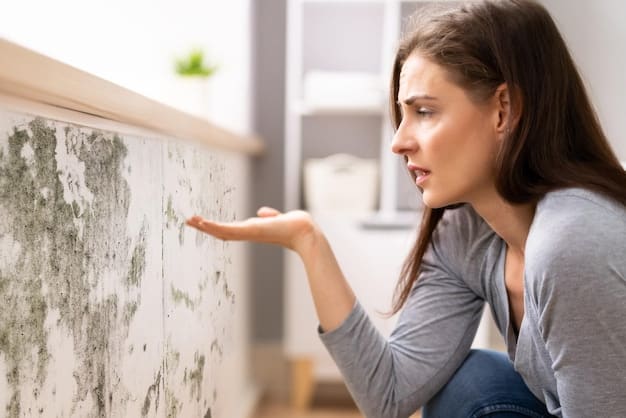Breathe Easy: Tips & Products to Improve Your Home’s Air Quality

Advertisements
Improve your home’s air quality by identifying pollution sources, increasing ventilation, using air purifiers, regularly cleaning, and choosing eco-friendly products for a healthier and more comfortable living environment.
Indoor air pollution can significantly impact your health and well-being. Fortunately, learning how to improve your home’s air quality is achievable with simple strategies and the right products. This article will guide you through essential tips and products to create a healthier home environment.
Advertisements
Understand the Importance of Indoor Air Quality
Indoor air quality is often overlooked, yet it plays a crucial role in our health. Poor air quality can lead to various health issues, from allergies and asthma to more severe respiratory problems. Understanding the sources of indoor air pollution is the first step to improving your living environment.
Several factors contribute to indoor air pollution, including:
Advertisements
- Combustion Sources: Furnaces, stoves, fireplaces, and heaters.
- Building Materials: Asbestos, formaldehyde, and radon.
- Household Products: Cleaners, pesticides, and personal care products.
- Outdoor Pollutants: Pollen, smog, and vehicle emissions.
By understanding these sources, you can take targeted actions to mitigate their impact on your home’s air quality.
Identify Sources of Indoor Air Pollution
The next step is identifying the specific pollutants affecting your home. This involves a bit of detective work, examining your lifestyle, habits, and the age of your home. Some common culprits include:
Dust and Allergens
Dust mites, pet dander, and pollen are common allergens that can accumulate indoors. Regular cleaning and using allergen-proof covers can help minimize their impact.
Mold and Mildew
Moist environments promote mold growth, releasing spores into the air. Address leaks promptly and ensure adequate ventilation in damp areas like bathrooms and basements.

Volatile Organic Compounds (VOCs)
VOCs are emitted from various household products, including paints, adhesives, and cleaning supplies. Opt for low-VOC or VOC-free alternatives to reduce exposure.
Once you’ve identified potential sources, you can implement targeted solutions to address them effectively.
Improve Ventilation in Your Home
Ventilation is key to diluting indoor pollutants and bringing in fresh air. Opening windows and doors is a simple yet effective way to improve air circulation, especially during periods of low outdoor pollution.
Consider these strategies to maximize ventilation:
- Natural Ventilation: Open windows and doors regularly, especially after activities that generate pollutants, such as cooking or cleaning.
- Mechanical Ventilation: Use exhaust fans in bathrooms and kitchens to remove moisture and odors.
- HVAC Systems: Ensure your HVAC system is properly maintained and equipped with high-quality filters to remove particles from the air.
Effective ventilation can significantly reduce the concentration of pollutants in your home.
Invest in Air Purifiers and Filters
Air purifiers and filters are essential tools for removing airborne particles and pollutants. Choose air purifiers with HEPA (High-Efficiency Particulate Air) filters, which can capture 99.97% of particles as small as 0.3 microns.
Key considerations when selecting air purifiers and filters include:
HEPA Filters
These filters are highly effective at removing dust, pollen, pet dander, and other allergens from the air.
Activated Carbon Filters
These filters can remove odors, gases, and VOCs, making them ideal for kitchens and areas with strong smells.
Coverage Area
Ensure the air purifier is appropriately sized for the room you intend to use it in.

Regularly replace filters according to the manufacturer’s recommendations to maintain optimal performance.
Maintain a Clean and Dust-Free Environment
Regular cleaning is crucial for removing accumulated pollutants and allergens. Dust and vacuum frequently, paying attention to areas where dust tends to collect, such as carpets, upholstery, and curtains.
Effective cleaning practices include:
- Dusting: Use a microfiber cloth to trap dust instead of spreading it around.
- Vacuuming: Choose a vacuum cleaner with a HEPA filter to capture fine particles.
- Mopping: Clean hard floors regularly to remove dirt and grime.
- Laundry: Wash bedding and curtains frequently to remove allergens.
By maintaining a clean environment, you can significantly reduce the level of indoor air pollution.
Choose Eco-Friendly and Non-Toxic Products
Many household products contain harmful chemicals that can contribute to indoor air pollution. Opt for eco-friendly and non-toxic alternatives whenever possible, including cleaning supplies, personal care products, and building materials.
Look for products labeled with certifications such as:
EPA Safer Choice
Products with this label have been evaluated for their environmental and human health impacts.
Green Seal
This certification identifies products that meet specific environmental performance standards.
Low-VOC or VOC-Free
These products emit fewer volatile organic compounds, reducing indoor air pollution.
Making conscious choices about the products you bring into your home can have a significant impact on air quality.
Control Humidity Levels
Maintaining proper humidity levels is essential for preventing mold growth and other moisture-related issues. Aim for a relative humidity between 30% and 50% to create a comfortable and healthy indoor environment.
Strategies for controlling humidity include:
- Dehumidifiers: Use dehumidifiers in damp areas to reduce moisture levels.
- Humidifiers: In dry climates, use humidifiers to add moisture to the air.
- Proper Ventilation: Ensure adequate ventilation in bathrooms and kitchens to remove excess moisture.
Monitoring and adjusting humidity levels can help prevent mold growth and improve overall air quality.
Regularly Inspect and Maintain Appliances
Faulty appliances can release pollutants into the air, posing a health risk to occupants. Regularly inspect and maintain appliances such as furnaces, stoves, and dryers to ensure they are functioning correctly.
Key maintenance tasks include:
Furnace Inspections
Schedule annual inspections to identify and address potential issues.
Stove Maintenance
Ensure proper ventilation and promptly repair any leaks or malfunctions.
Dryer Vent Cleaning
Clean the dryer vent regularly to prevent lint buildup and reduce the risk of fire.
Proper maintenance can prevent appliances from becoming sources of indoor air pollution. By applying these tips, homeowners can improve their home’s air quality and enjoy a healthier living environment.
| Key Point | Brief Description |
|---|---|
| 🌬️ Ventilation | Opening windows & using exhaust fans to circulate fresh air. |
| 🧽 Cleaning | Regular dusting, vacuuming, and mopping to remove allergens. |
| 🌱 Eco-Products | Using non-toxic cleaners and low-VOC paints for a healthier home. |
| 💨 Air Purifiers | Investing in HEPA filters to eliminate airborne particles. |
Frequently Asked Questions (FAQ)
▼
Dusting at least once a week helps reduce allergens. Focus on surfaces like shelves, furniture, and window sills where dust accumulates. Use a microfiber cloth for best results.
▼
Yes, especially if you have allergies or asthma. Air purifiers with HEPA filters can remove most airborne particles, improving indoor air quality and reducing respiratory issues.
▼
Choose low-VOC paints, furniture, and cleaning products. Ensure good ventilation when using products that emit VOCs. Allow new items to off-gas in a well-ventilated area before bringing them inside.
▼
The ideal humidity level is between 30% and 50%. This range prevents mold growth and reduces dust mites. Use a humidifier or dehumidifier to maintain the correct humidity.
▼
Ensure proper ventilation by using a dehumidifier. Seal any cracks in walls or floors. Regularly inspect for leaks and address them promptly. Clean any surfaces showing mold growth immediately.
Conclusion
Improving your home’s air quality is a vital step towards creating a healthier and more comfortable living environment. By identifying pollution sources, increasing ventilation, using air purifiers, maintaining a clean environment, and choosing eco-friendly products, you can significantly reduce indoor air pollution and enjoy a safer, healthier home.